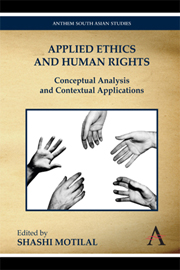Book contents
- Frontmatter
- Contents
- Preface
- Introduction
- Part One Rights, Obligations and Responsibilities
- 1 Applying Ethics: Modes, Motives and Levels of Commitment
- 2 Jurisprudence and the Individual: Bridging the General and the Particular
- 3 Why Moral Relativism Does Not Make Sense
- 4 Human Rights – A Theoretical Foray
- 5 Moral Relativism and Human Rights
- 6 Complicity and Responsibility
- 7 Dharma: The Overriding Principle of Indian Life and Thought
- 8 Moral Foundations of Social Order as Suggested in the Vaiśeṣikasūtras
- 9 Modern Western Conception of Justice as Equality before the Law and Dharmaśāstras
- Part Two Human Rights Issues
- Notes on Contributors
9 - Modern Western Conception of Justice as Equality before the Law and Dharmaśāstras
from Part One - Rights, Obligations and Responsibilities
Published online by Cambridge University Press: 05 March 2012
- Frontmatter
- Contents
- Preface
- Introduction
- Part One Rights, Obligations and Responsibilities
- 1 Applying Ethics: Modes, Motives and Levels of Commitment
- 2 Jurisprudence and the Individual: Bridging the General and the Particular
- 3 Why Moral Relativism Does Not Make Sense
- 4 Human Rights – A Theoretical Foray
- 5 Moral Relativism and Human Rights
- 6 Complicity and Responsibility
- 7 Dharma: The Overriding Principle of Indian Life and Thought
- 8 Moral Foundations of Social Order as Suggested in the Vaiśeṣikasūtras
- 9 Modern Western Conception of Justice as Equality before the Law and Dharmaśāstras
- Part Two Human Rights Issues
- Notes on Contributors
Summary
While the awareness of the value of justice is quite widespread in western thought, its understanding or content has been changing with times. Plato's famous conception of justice as harmonious functioning of various parts of the individual and the society does not seem to have any place for the idea of equal dignity and rights of all human beings. This latter idea is present in Aristotle's conception of justice as lawfulness and fairness or equitability. But neither for Aristotle, nor for later medieval Christian thinkers, did the notion of justice imply the rejection of the institution of slavery.
Justice was conceived throughout the medieval period according to Greek thinker Ulpian's definition as ‘giving to each what is his own (or due)’. This, as pointed out by Hans Kelsen (1957: 13) and others, leaves enough scope for any amount of social disparities and inequalities, as our understanding of what is due to someone is determined by the sociopolitical order. For example, the slaves in the ancient Greek society and the shudras in the Vedic-dharmasastric social order could claim little as their due.
It is in modern thought alone that the idea of basic equality of all human beings, especially before the law, is made central to the conception of justice. The humanism of Renaissance; the rationalism of Enlightenment and the liberalism of nineteenth century – all led to the emphasis on the dignity of the individual per se and the equality of all human beings.
- Type
- Chapter
- Information
- Applied Ethics and Human RightsConceptual Analysis and Contextual Applications, pp. 109 - 126Publisher: Anthem PressPrint publication year: 2010



